Pam Buckley graduated from Babson in 1989, following in the footsteps of her father, Raymond J. Acciardo Sr. MBA’69. She has enjoyed a successful career in banking and compliance, and currently lives in Wellesley, Massachusetts, with her husband, Tim, and their college-bound twins. Buckley has been donating to Babson since 1996, and for the past two years has been volunteering as a class agent for the Class of 1989. Buckley also is a member of the Reunion Committee, having just enjoyed a very successful 30th reunion!
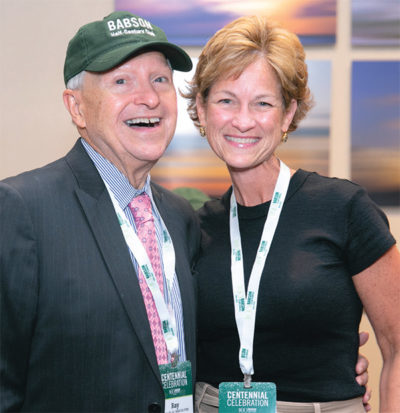
Pam Buckley ’89 and her father, Raymond J. Acciardo Sr. MBA’69, who also celebrated a milestone—his 50th reunion, joining the ranks of the Half-Century Club.
Photo: Paige Brown
What’s your favorite way to start the day?
Generally, with a cup of coffee and often a spin or TRAIN class at B/Spoke, when not immediately jumping on the laptop and getting right into my work day. I wake up, greet my family, read the Daily Skimm, and then hit the ground running. I’m a morning person, so I like to get right into the day!
Your twins are in the middle of the college search right now. Has that process given you a new perspective on Babson?
Absolutely! It’s been so fun touring colleges and universities around the country, realizing how fortunate I am to have attended Babson. The College always provides great opportunities to network, learn from others, engage with alumni, and connect with current students. The Babson community is unique in that it attracts so many interesting, intelligent, and ambitious people from around the globe.
What motivated you to become a class agent?
As a cancer survivor, I’ve always believed in giving back and the importance of volunteerism. It’s core to who I am. Before my husband and I had children, I dedicated 10 years to the Jimmy Fund Council of Greater Boston, serving as treasurer and secretary. Tim and I also rode in the Pan-Mass Challenge eight times, raising money for the Dana-Farber Cancer Institute, where I was treated for Hodgkin’s disease in 1990 (shortly after graduating from Babson). This was an exciting time to re-engage with Babson’s Centennial with my 30th Reunion in sight.
You’ve been donating consistently to Babson for nearly 20 years. Why?
Babson is near and dear to my heart. I look back and am so appreciative of all the opportunities I had on campus. I received a phenomenal education here, which positioned me well for a successful career and a happy, comfortable life. I’m just delighted to give back, and hopefully incent others to do the same. – Jason Lynch
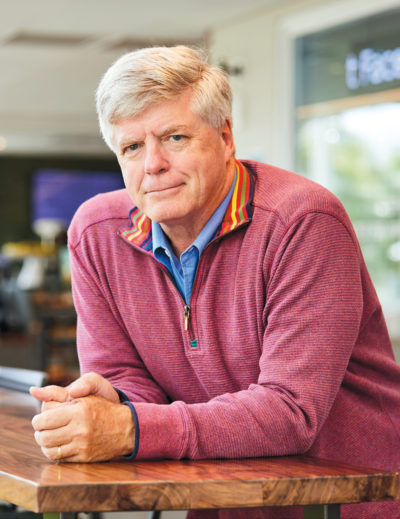
“There is not cause for mass panic. The fact is that nobody really knows the percentage of jobs that will be automated over what time frame.” – Tom Davenport, the President’s Distinguished Professor of Information Technology and Management
Photo: Pat Piasecki
Let’s clear up one thing first: Contrary to what you may have seen in the movies, killer robots won’t be running amok anytime soon.
“There is not much evidence that killer robots are coming for us in the foreseeable future,” says Tom Davenport, the President’s Distinguished Professor of Information Technology and Management.
That’s not to say that the never-ending march of technology, particularly in regard to artificial intelligence (AI) and machine learning, doesn’t pose legitimate concerns about bias, misinformation, and a host of other possible issues. As AI grows more sophisticated, it will become a greater part of our workplaces and our lives.
For now, at least, the changes brought by AI are incremental, says Davenport, who has written two books on the technology, including The AI Advantage: How to Put the Artificial Intelligence Revolution to Work. Davenport tends to believe in Amara’s Law, which says humanity typically overestimates the effect of a new technology in the short run and underestimates the effect in the long run. “So far, the changes with AI are evolutionary rather than revolutionary,” he says. “It’s not something to be scared of.” Instead of fear, what AI represents is opportunity. For workers, AI potentially offers a way to do their jobs better. Furthermore, for entrepreneurs and business leaders, the new technology means new ventures, new ways of thinking, and new possibilities. Davenport encourages all businesses to look into AI. “You don’t want to be left behind,” he says.
AI at Work
Perhaps the biggest concern about AI is the potential loss of jobs from the technology. Just how many jobs could be lost, though, remains unknown. Headline-grabbing reports predicting massive unemployment appear to be overblown, Davenport says. “There is not cause for mass panic. The fact is that nobody really knows the percentage of jobs that will be automated over what time frame.”
Of course, some jobs are at more risk than others. Jobs that require empathy, creativity, or flexibility are harder to replicate than those with repetitive, predictable tasks. Jobs that require direct human contact (nursing, for example) also are safer than those that are predominantly performed digitally (radiology). “You want to make sure you are doing things that aren’t easily replaced by a machine,” Davenport says. “My son is a TV comedy writer. Machines are very bad at comedy writing.”
In many workplaces, however, employees may find their jobs augmented, rather than automated, by AI. Instead of replacing humans, says Davenport, machines could complement them and serve as a colleague of sorts, performing tedious tasks or helping workers make complex decisions.
One company bringing AI to the workplace is Gravyty, a provider of AI-enabled fundraising software. Based in Newton, Massachusetts, Gravyty works with colleges, hospitals, and other nonprofit organizations that are tackling a range of serious societal challenges, such as treating Alzheimer’s disease, curing cancer, and eradicating poverty.
“Our mission is helping their mission,” says Gravyty’s chief technology officer, Rich Palmer MBA’16, who co-founded the company with CEO Adam Martel, a Babson MBA candidate who once worked in the College’s development office. “We take inspiration from all of our clients. They are doing all kinds of beautiful things for the world.”
Gravyty offers clients a variety of AI-powered capabilities. Its software, for instance, can identify and prioritize potential donors in each client’s network.
One organization was able to land a $50 million gift after Gravyty software singled out a new potential donor. “He was in a pool of people they knew about, but no one had previously taken the time to talk to him,” Palmer says.
Gravyty’s software can draft emails to send to donors, and when fundraisers make edits to those emails, the AI is taking note. “The AI system is constantly learning how you talk,” Palmer says. “The more you use the system, the better it gets. The next time an email comes up, it’s a little better.”
Gravyty also can help clients organize their fundraising trips, figure out which potential donors to meet for coffee or take to dinner, and even suggest restaurants where they should dine. That scheduling can save fundraising staff a lot of time.
“Fundraisers already do a lot of this, but it may take them all day to set up a meeting,” Palmer says. In fact, Gravyty case studies have shown that its products enable one fundraiser to do the work of 10. Have a staff of 10, the company claims, and they can now do the work of 100.
That’s welcome news for an industry that is always in need of talent. “There is a lot of turnover,” Palmer says. “Every nonprofit has open jobs now.”
AI in Our Lives
Outside the workplace, AI may influence our lives in myriad other ways in the future, says Davenport. To name just a few possibilities, AI may help analyze the human genome, assist doctors in predicting who might have a heart attack, or increase the mobility of seniors through autonomous vehicles.
Waycare, based in Los Angeles and Tel Aviv, Israel, is using AI to create safer, less-clogged roadways. Typically, says co-founder and CEO Noam Maital ’12, accidents and congestion are responded to after the fact. Two cars collide, and that’s when police are called to the scene. Traffic backs up, and that’s when motorists are notified of the delay by phones and news reports. “A big problem is that we are reactive by nature,” Maital says.
Waycare seeks to change that. Utilized by municipalities and departments of transportation, Waycare’s AI platform analyzes all kinds of data—from accident reports to traffic cameras to weather forecasts to navigation apps on driver smartphones—to predict congestion and accidents before they happen. “The data is overwhelming, but it can be turned into actionable insights in real time,” Maital says.
That’s what happened in Las Vegas. Waycare was used to cut vehicle crashes by 17 percent on a stretch of city interstate last year. The company identified when and where crashes were likely to happen, and then government agencies took steps to reduce motorists’ speed. Digital highway signs prompted motorists to slow down, and police cars with flashing lights were stationed in high-risk areas.
For cities dealing with traffic problems, Maital thinks technology offers a better and more cost-effective solution than trying to expand roadways and overhaul infrastructure. “They can’t pave themselves out of the problem fast enough,” he says. “They have to be smarter.”
Waycare and Gravyty illustrate the capability that AI has to improve our day-to-day lives, both in the office and out. They also show AI’s business potential, which is far-reaching. “In my mind, no industry is immune to the transformational potential of AI,” says Gravyty’s Palmer.
Indeed, the technology is moving ever forward. That relentless progress is not something to fear, but it’s also not something to ignore. “There are serious first-mover advantages to adopting AI,” Palmer says. “Now is the time for entrepreneurs of all kinds to put AI to work or they’ll fall behind, and it may be hard to catch up.”
]]>
Palak Shah MBA’16
Cut from a Different Cloth
An article in The New Indian Express explored the collaboration between Ekaya Banaras, a company founded by Palak Shah MBA’16, and Indian designer Masaba Gupta. Shah, who has done designer collaborations before, was quoted as saying, “The reason we collaborate is to experiment and bring about a change in the way Indian textiles are engineered and worked on.”

Simone Aptekman ’15, MBA’16
A Model Life
The life of a model may seem like nonstop glamour, but Simone Aptekman ’15, MBA’16 knows there’s another side. Aptekman, a working model, spoke with TheFashionSpot.com about co-creating the Model’s Bill of Rights to protect models’ legal rights regarding contracts, payment, and work environment. “I believe it is a very timely and relevant movement,” she said in the article.

Mayura Davda-Shah MS’16
Fishing for Sustainability
Vogue India featured Mayura Davda-Shah MS’16 in an article on eco-friendly fabric. Davda-Shah uses sustainable fish skin leather for her Mayu collection of luxury accessories. Alternative leathers, she said in the article, “are certainly offering the next big wave of innovative, sustainable material options for new-age design houses like ours.”
]]>The founder of Alps & Meters, a luxury line of ski jackets and alpine sportswear, has been hands on with the Management Consulting Field Experience (MCFE) program for about four years, and says, “It’s very clear the kids at Babson exude entrepreneurship through every pore.”
Run by Arline MacCormack, associate director for Experiential Education, and management professor Joseph Weintraub, MCFE offers teams of students the chance to gain experience working with Boston-area business professionals.
As a professional with years of brand and creative experience in multiple global fashion companies, Joseph has been helping students learn experientially through MCFE while they provide his company with the latest innovation tools and resources.

Louis Joseph MBA’05
In the past, students have contributed by assessing and developing Alps & Meters market entry strategy for women, as well as the company’s luxury customer experience approach.
Joseph says the students’ research methodologies drive insight and action, delivering positive return on investment.
“Babson’s MCFE teams are armed with cutting-edge research abilities, tools, and passion,” he says.
Joseph previously worked at K-Swiss as vice president of global marketing, at New Balance as global brand manager for running, and at Puma as global director of strategy and innovation.
In 2014, Joseph established Alps & Meters, which was inspired by a trip to Sweden. Products include polo shirts, vests, parkas, and backpacks.
Joseph says Babson students are adept when it comes to research and describes their approach as “incredibly sophisticated.” He attributes that mindset to faculty and leadership who have a wealth of entrepreneurial experience.
“It’s been a fantastic extended relationship. I continue to be impressed with the student body, who are effectively on the cutting edge of the next wave of entrepreneurial endeavors.”
Joseph considers Babson a continuous partner and resource for his success.
“Mentorship for me is a virtuous cycle,” Joseph says, adding that he has acquired research skills, financial model possibilities, and improved marketing frameworks from working with the students. “I’ve learned legitimately as much from the students as they’ve learned from me.” – Bryan Lipiner
]]>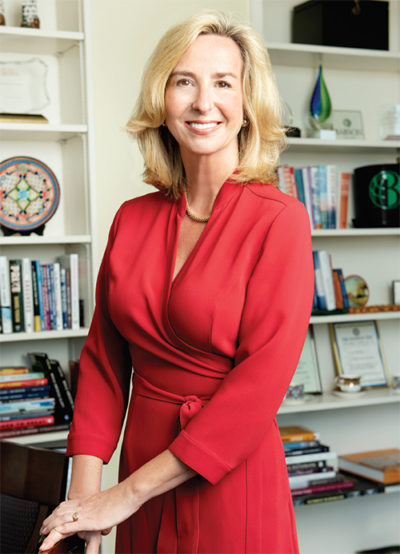
Photo: Webb Chappell
Babson President Kerry Healey
In September, U.S. News & World Report ranked Babson the No. 1 undergraduate program for entrepreneurship a remarkable 22nd consecutive time. This is an unprecedented achievement and a testament to Babson’s continued leadership in entrepreneurship education.
Some four decades ago, Babson pioneered entrepreneurship as an academic discipline, based on the revolutionary belief that entrepreneurs can be made and are not just born. We redefined entrepreneurship to mean more than simply starting a business. Instead, we educate leaders who think and act entrepreneurially in all settings, from family enterprises and startups to social ventures and established corporations.
Today, we are preparing entrepreneurs of all kinds to lead in a new way, creating social and economic value simultaneously and, in doing so, transforming lives, businesses, and communities for the better. And we are working hard to make Entrepreneurial Thought & Action accessible to everyone, everywhere.
Last year, Babson awarded $44 million in institutional grants and scholarships, and, for the first time in nearly two decades, met 100 percent of demonstrated need for incoming domestic undergraduates. Babson is enriched by the presence of our extraordinary Global Scholars, Posse Scholars, Diversity Leadership Scholars, Center for Women’s Entrepreneurial Leadership Scholars, Presidential Scholars, and many others. We know that everywhere on campus, in every situation, there are aspiring leaders with the potential to change the world for the better.
A significant portion of scholarship dollars comes from philanthropy. The generosity of the Babson community enables us to recruit globally, have impact locally, increase selectivity, and offer financial support to the world’s most talented and promising entrepreneurial students.
Babson’s fundraising and alumni engagement reached historic levels in fiscal year 2018. With more than $67 million raised in support of Babson’s people, programs, and campus, we surpassed 10,000 donors for the first time in College history, and we exceeded our participation goal to end the year with a record 30.5 percent of alumni giving to the College.
Since 2012, alumni participation has increased an incredible 135 percent. This is thanks to all of you. Our exceptional global network of 41,000 alumni in 119 countries is among our greatest strengths, and I am incredibly grateful for the ongoing commitment of our community.
Looking ahead to our Centennial, we have so many exciting plans in place. Babson is poised for a second century of innovation and leadership. Our campus is transforming, our community is growing, and our reputation is stronger than ever. I hope you will join us on campus soon and experience the excitement with us in person.

Kerry Healey
]]>Kapor invests in companies seeking to address societal issues. Its diverse portfolio, which currently includes about 130 companies, encompasses such enterprises as Magoosh, a provider of affordable study prep for standardized tests; Velano Vascular, which aims to improve the way blood is drawn in hospitals; Honor, an online service that connects in-home caregivers with seniors and their families; Pigeonly, which offers an inexpensive way for people to communicate with incarcerated family members; and LendUp, a socially responsible lender that provides loans and credit cards to people with insufficient credit.
Working with these companies, Dixon has come to realize how personal they are for the entrepreneurs behind them. Pigeonly, for instance, was launched by someone who was once incarcerated, and one of the founders of Velano Vascular has Crohn’s disease and has spent much time in hospitals. If he asks the entrepreneurs why they started their companies, they will tell him from the heart about their experiences. “When you ask that question, there is something personal,” Dixon says. “That story of the lived experience is what separates someone who will go above and beyond to see an idea through.”
By backing entrepreneurs who are following their personal passions to make change, Dixon and his colleagues at Kapor are making a deep commitment to impact investing. A growing trend in the financial world, impact investing has two main goals. The first is a traditional one: to make a profit. But impact investing also is concerned with social and environmental returns on investment. Kapor, for example, focuses on tech companies trying to close gaps of access, opportunity, or outcome for low-income communities and communities of color. Health, education, and finance are among the sectors in which it invests.
When considering what venture to support, Kapor is certainly looking at a company’s financial health and potential, but the firm also is interested in a far bigger question: Can the company make the world a better place? “The impact companies that do it right think of all stakeholders,” Dixon says. “We hope as they grow, their impact will grow as well.”
More Socially Aware
Impact investing has grown out of a broader movement, that of investors becoming more attuned to the societal effects of their investments. Millennials and women, in particular, are increasingly thinking beyond bottom-line concerns, says Priya Parrish ’05, partner and chief investment office at Impact Engine, a Chicago investment firm committed to making positive social and environmental change. “It makes sense,” Parrish says. “People think about the implications of the items that they buy. Why not think about it regarding your investment portfolio?”
An early example of this socially aware thinking came during the era of apartheid in South Africa, when investors divested their money from companies doing business in the country. Investors also have chosen not to put their money in companies that don’t align with their values, avoiding, say, alcohol, gambling, or tobacco businesses.
A popular form of this socially conscious investing is known as Environmental, Social, and Governance, or ESG for short, and it focuses on what its name implies. Financial performance is still the main objective, but ESG investors will look at environmental (how much carbon is the company emitting?), social (how does the company treat its workforce?), and governance (how transparent is the company?) factors as part of a routine evaluation of a business. According to Morgan Stanley, nearly $23 trillion in investments, roughly one-quarter of all assets managed around the world, have some sort of ESG mandate.
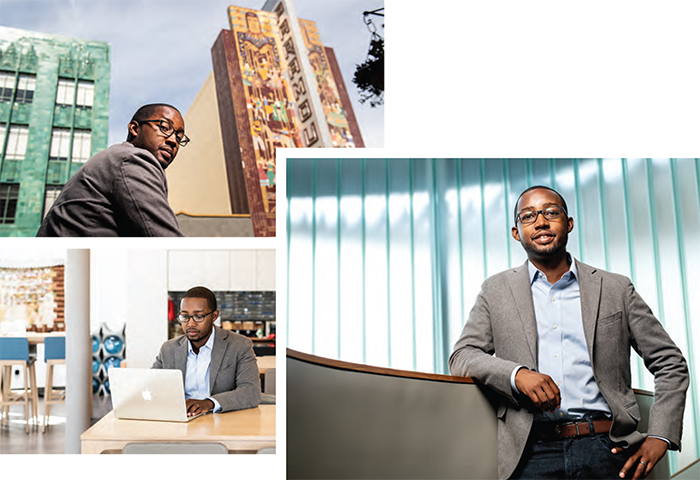
Photos: Winni Wintermeyer
“It’s trending. People are voting with their money,” says Patrick Gregory, senior lecturer of finance at Babson and director of the Stephen D. Cutler Center for Investments and Finance. “It’s an area of interest to our students.”
The Babson College Fund, a group of about 25 students charged with managing a portion (just under $3 million) of the College’s endowment, considers ESG in its stock evaluations. “Our mandate is to outperform the S&P 500,” says Gregory, the fund’s director. “We have discretion on how we do that, and we do that by taking a 360-degree view of a company.”
Incorporating ESG has not hurt the fund’s returns, mirroring the experience of many other investors who were initially skeptical of ESG. “For many, that was a concern, that they would have to give up performance,” says Gregory. “But investor thinking has evolved.”
Impact investing, as practiced by alumni such as Dixon at Kapor and Parrish at Impact Engine, takes the socially aware investing of ESG one step further. Instead of simply taking ESG factors into account when doing a broad evaluation of stocks, impact investors have a much more active approach, directly supporting companies with a social mission. “Impact investing is the intention to create change,” says Parrish. “When you’re betting on a business, you’re betting on its impact.”
Compared with ESG, impact investing is not as widely practiced, though its numbers are still impressive and growing. In a survey of more than 200 leading impact-investing organizations, the Global Impact Investing Network, a nonprofit dedicated to championing and increasing this type of investing, found that respondents cumulatively managed $228 billion in assets. “When you look at the broad trends in investing, it’s one of the top 10,” Parrish says. “Impact investing is right up there.”
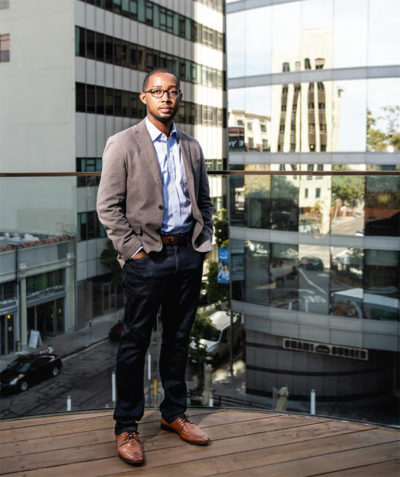
Photo: Winni Wintermeyer
At Kapor Capital, Brian Dixon and his colleagues focus on tech companies trying to close gaps of access, opportunity, or outcome for low-income communities and communities of color.
At the heart of impact investing lies the belief that business has the potential to address and solve intractable problems. “Philanthropy and government and traditional forms of investing are not sufficient to address the dilemmas the world faces today,” says Cheryl Kiser, executive director of Babson’s Lewis Institute for Social Innovation. “Philanthropy can only take you so far. Impact investing is a whole new frontier. It is using the mechanisms of finance in different ways to advance social progress. It’s a new way of financing the future.”
Parrish agrees. “The idea of business having a seat at the table for solving problems isn’t going away,” she says. Furthermore, impact investing is a way to empower typical investors, enabling them to make an immediate difference in issues that concern them. “The old way of making enough money to then give it away doesn’t work,” Parrish says. “Look at the state of our society. There are enough pressing problems. Impact investing is a way for everyone to feel like they’re doing something now. That resonates.”
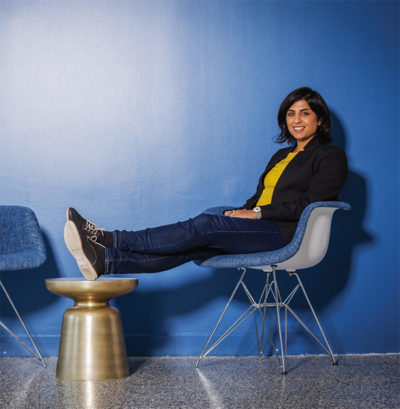
Photo: Bob Stefko
Priya Parrish ’05 is partner and chief investment office at Impact Engine in Chicago.
The World Has Shifted
Parrish didn’t intend to become an impact investor. As a Babson student, she lived in E-Tower, started a few businesses, and planned to become an entrepreneur. But then she enrolled in a social entrepreneurship class with professor Natalie Taylor, and she took an independent study with professor James Hoopes, looking at corporations’ role in addressing societal issues. “My social conscience was developing. I wanted to do something for the world, but I didn’t want to be a social worker,” she says. “I saw that for-profit companies were a powerful tool to solve social issues.”
Before she even graduated from Babson, Parrish took a job at a small research firm, working on growing its ESG index. Such socially aware investing wasn’t as common then. “Most of my friends thought I was nuts,” Parrish says. “I was doing well at Babson. I had job opportunities. My friends were asking, ‘What are you doing?’ ” Other jobs in investing followed through the years, some with a socially conscious bent, others not. Parrish has witnessed how ESG and impact investing have become more accepted and widespread. “No one is saying anymore, ‘What are you doing?’ ” she says. “The world has shifted. Everyone knows what I’m talking about.”

Photo: Bob Stefko
The world of impact investing has become almost synonymous with new ventures, so at Impact Engine, Priya Parrish is putting together a private equity fund focusing on more established businesses. “I want to support mission-driven companies that are scaling,” she says.
Today, Parrish is the impact investor in residence at the University of Chicago’s Booth School of Business, where she earned her MBA in 2009, and she has worked at Impact Engine since April. While the firm generally invests in early-stage tech companies that target issues such as resource efficiency, education, health, and economic empowerment, Parrish is busy putting together a private equity fund that focuses on more established businesses.
The world of impact investing, she says, has become almost synonymous with new ventures. Older companies can be overlooked. “I don’t want to put 100 percent of my money in venture capital,” she says. “I want to support mission-driven companies that are scaling.”
More established companies certainly face challenges, says Kapor Capital’s Brian Dixon. As they age, they may drift from the social missions that so defined them in their early days, alienating customers and employees who were drawn to them because of that mission. For instance, a company that donates one item for every one it sells, a common business model used by companies selling eyeglasses, books, and a host of other products, may one day be tempted to stop donating that second item and pocket the extra profits instead. “As the company gets bigger, how do they keep that core mission?” Dixon asks.
Like Parrish, Dixon once pursued entrepreneurial ventures. As a teenager, he founded a custom sneaker company. His proudest moment was seeing a picture of basketball superstar LeBron James holding one of his shoes. “I was blown away,” Dixon says. “I’ve been showing that picture to people for a decade now. It still gets me fired up.”
Later, he was co-founder and CEO of a social networking aggregator that drew attention from investors. That was the first time he saw up close the work that venture capitalists do. “I thought, ‘This is something I want to do,’” Dixon recalls. While he majored in computer science in college and worked as an IT analyst, Dixon eventually decided to earn his MBA and focus on venture capital. He did a couple of internships at Kapor before joining as an associate after graduating from Babson. He was named a partner in 2015.
A big part of Kapor’s mission is to make sure that entrepreneurs from all backgrounds are heard. If entrepreneurs want to reach out to Kapor, they don’t need to network to find the right people to contact. All they have to do is fill out a form on the firm’s website. Every Monday, the firm’s staff pore over the submissions. “Not all entrepreneurs end up at great schools or have a great network. They should still have a chance to grow a business,” Dixon says. “A lot of pitches come over the website. We look at each one.”
Kapor employs a diverse team in an industry, venture capital, not known for its diversity. By having staff from all walks of life, the Kapor team hopes, in turn, to identify more readily with all kinds of entrepreneurs, regardless of their background. The team may even have firsthand experience dealing with the social issues the entrepreneurs are trying to address. Dixon, for instance, remembers his parents sacrificing to scrape enough money together to send him to SAT prep classes, so he identifies with the mission of the company Magoosh, the provider of affordable study prep for standardized tests. “You get attracted to companies that speak to your soul,” Dixon says.
Since 2016, all companies that Kapor invests in are also required to sign the Founder’s Commitment, which calls on ventures to establish diversity and inclusion goals, invest in tools and training that mitigate bias in hiring and promotion, and organize volunteer opportunities in the underserved communities that reflect a company’s customer base. “The whole mission is to diversify tech. The tech industry does not look like America,” Dixon says. “Why not build in diversity and inclusion from the start?”
Urgent and Necessary
Impact investing may be a growing movement, but it’s still relatively new. The Lewis Institute’s Cheryl Kiser often encounters students who want to solve a social problem, but they tend to focus on traditional solutions such as starting a nonprofit. She’ll point out the potential of impact investing to them. “How do you figure out our unique contribution to solving that problem?” Kiser will ask them. “It could be in the realm of finance.”
Impact investing also has to contend with perceptions of subpar returns. Many assume that making a social impact means sacrificing profit. That assumption, however, isn’t necessary true. “The numbers will prove out otherwise,” Dixon says. “We have early signs that you can do both.” If anything, the challenge for impact investors is measuring their social and environmental returns on investment. Dollars and cents are easy to track, but progress on a societal problem can be slow and hard to quantify. Patience is required. As Kiser says, “You can’t solve a social problem in a quarter.”
But addressing problems, even daunting ones that are global in scale, is something that impact investing can do very well, believes John Kluge, MBA’17. The Babson trustee is the founder and managing director of the Refugee Investment Network, an impact investing and blended finance collaborative based in Washington. According to the United Nations High Commissioner for Refugees, 68.5 million people were displaced from their homes in 2017, and Kluge’s organization is working to address this crisis by providing research and facilitating deals to spur investment in refugee entrepreneurs and the communities where they live.

Photos: Bob Stefko
Kluge calls impact investing “urgent and necessary.” From accessing clean drinking water to eradicating poverty, Kluge says, “I have not come across a solution yet where there isn’t some way for impact capital to be utilized.” His attention was drawn to refugees by his wife, University of Virginia professor Christine Mahoney, whose 2016 book, Failure and Hope: Fighting for the Rights of the Forcibly Displaced, asserts that entrepreneurship is a way to improve their lives.
“She showed me that while forced migration is a massive crisis, it’s filled with hope, resilience, and opportunity,” Kluge says. “Every person, regardless of where they came from or why they have traveled, deserves a life of dignity and a chance to fulfill their potential, which we know is immense.”
While a number of humanitarian organizations are helping with the refugee crisis, Kluge says private investors are typically not involved. The Refugee Investment Network hopes to change that. “We’re proving that refugees and other displaced communities are investable, and that there is a defined, growing, and diversifying market to invest in with displaced people,” he says.
As the field of impact investing continues to expand, Kluge hopes investors are aware of the power that their money can have, whether with displaced people or the myriad other problems that we as a society face around the world. “How do we render finance in service to humanity?” Kluge says. “All investing has an impact. The question is whether you’re aware of it, intentional about it, and whether or not you are making an impact that is positive.”
]]>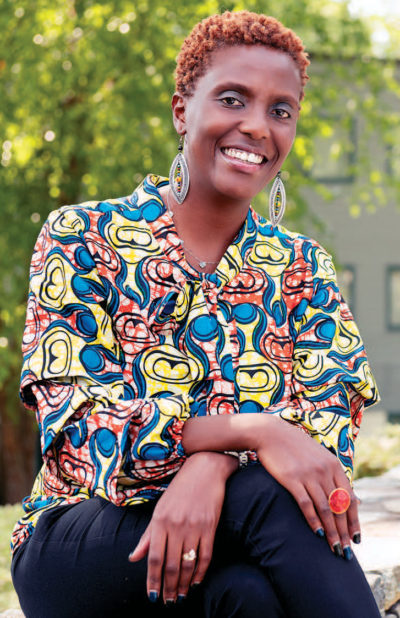
Photo: Webb Chappell
Waceke Nduati has been a participant and an instructor in the “Launch and Grow” program.
“At Babson, I had an ‘aha moment,’” Waceke says. “Women carry a lot of ‘we’re not good enough,’ no matter what fantastic things we’ve done. But I realized, ‘My goodness, I am enough.’ You leave Babson knowing you are enough.”
And that is more or less the point of the program, says Susan Duffy, executive director of the Center for Women’s Entrepreneurial Leadership, who co-leads the program with Mary Gale, senior lecturer of entrepreneurship. “A lot of what we’re doing,” says Duffy, “is opening thinking around how big and bold you can be, to really change expectations around what kind of impact you can have.”
Participants have represented a range of industries, from sports to fashion to marketing to food. They face many of the same challenges that entrepreneurs often confront, but, as women and Kenyans, they encounter other obstacles as well. For example, Waceke explains, “Historically, women have not been inheritors of property and do not have the traditional security that banks want.” Hence, just obtaining a loan can be difficult.
The program offers concrete skill building, with classes on pitching, operations, and finance. But what Duffy describes as “Babson’s special sauce” is the ability to create an environment that promotes what she calls “self-efficacy.” The women test and try ideas, learn from not just the faculty but their cohort, share stories, help ease one another’s anxieties, and act as champions for one another. “Those elements combine to create an environment where people say, ‘I’ve got this.’ That’s self-efficacy,” Duffy says. “They might come in thinking, ‘Well, I have this business,’ but they leave thinking, ‘I’m just getting started; the sky’s the limit.’”
Waceke says she joined the 2017 cohort because she wanted to be in a different environment and gain new perspectives. “I was at that stage where I was tired of hearing my own voice,” she says. The program made her realize that her organization needed a cultural shift. “I cannot be the only entrepreneur in the company,” she says. “I had to create an entrepreneurial culture. Setting up ET&A was the first thing I did when I came back.”
This year, Waceke returned to the program as an instructor, co-teaching a session with Mary Gale. Waceke was excited to help her countrywomen undergo the process she found so invaluable. “The program showed me how to think like a leader,” she says. “It is really transformational.”—Jane Dornbusch
]]>
A Preventive Approach to Health »
After studying and working in the U.S. for eight years, Chinmoy Mishra, MBA’08, returned home to India in 2012 to address what he calls crucial public-health issues.

Prescribing with Precision »
Kristine Ashcraft, MBA’10, likes to employ the metaphor of a five-highway intersection when describing how Seattle-based YouScript helps deliver precision medicine.

Smooth Operations »
Operating rooms. Cadaver labs. An ever-changing surgery schedule. For Joanna Geisinger, MBA’17, these were part of everyday life as a surgical device representative.

A Way Out of the Dark »
Andres Martin’s cognitive decline “sprung out of nowhere” about five years ago when he was 17, says his older sister, Magala ’17. He gradually went from being a healthy teen to not speaking, not sleeping, and barely moving.

A Lifeline in Times of Trouble »
In 2017, Hurricanes Irma and Maria devastated much of Puerto Rico. Access to basic medical supplies was crucial. During those difficult times, Puerto Rico Hospital Supply, for which Felix Santos ’78, P’16, is CEO, never closed.
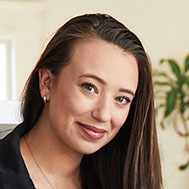
Help with Living a “Normal” Life »
One of the constant challenges of living with a long-term illness, such as Crohn’s disease, diabetes, or cancer, actually has nothing to do with what is happening inside the body, says Emily Levy ’16.
Clearly, the system could use a healthy dose of innovation, the kind entrepreneurs are poised to provide. For example, in a bold move, Berkshire Hathaway, Amazon, and JPMorgan Chase recently announced a partnership to launch an independent health-care company for their employees. In the announcement, billionaire entrepreneur Warren Buffett said: “The ballooning costs of health care act as a hungry tapeworm on the American economy.”
Babson-educated physicians agree that entrepreneurial steps are needed. Despite their varying specialties and professional goals, these doctors believe their entrepreneurial training gives them an edge. “If long-established companies don’t continue to evolve, then we will see others coming into this industry and disrupting it,” says Dr. Carolyn Langer, former chief medical officer for MassHealth, the Massachusetts Medicaid program, and a current Evening MBA student.
Doctors need to consider how they compete in their own industry, adds Dr. Renee Edwards, MBA’10, vice president, chief medical officer of Oregon Health & Science University (OHSU) HealthCare in Portland, Oregon. “I believe doctors have to be at the forefront of that conversation.”
Beyond Medical Knowledge
Edwards, a urogynecologist who specializes in pelvic reconstructive surgery for women, moved to OHSU after completing her medical education, residency, and fellowship in Chicago. In 2000, after just one year, she became medical director of its Center for Women’s Health, which Edwards says took a multidisciplinary approach to care long before this was common. “Health care tends to be highly siloed,” Edwards says, but patients don’t think that way. “More and more, medicine is saying, ‘How do we create an experience for the patient that’s basically one-stop shopping?’”
Although Edwards initially felt drawn to medicine to help people, she also found herself engaged by the systems that are an integral part of health care. “I’ve always been interested in considering how all the pieces are interconnected, how we deliver our product and work to improve it, for both the patient and the people working in the system,” she says. But she saw gaps in her business knowledge and so decided to pursue an MBA through Babson’s West Coast program, located at the time in Portland, Oregon. “I needed to look outside traditional medical thinking,” Edwards says.
She loved interacting with fellow students from such industries as technology, retail, and film. “It taught me to think beyond my own knowledge base, to think intentionally about who else I needed on my team,” she says. “In the eight years since I completed my MBA, medicine has become much more about how we work in teams, how we build these multidisciplinary models.”
Edwards believes her time at Babson prepared her for this shift, leading to her recent promotion to chief medical officer. “The more doctors understand the business of medicine, the more they appreciate the pressures that are being applied in health care today,” Edwards says. “Unless we understand those pressures, we cannot be articulate in the discussion.”
Speaking the Same Language
Dr. Art Mourtzinos, MBA’12, was thinking in business terms long before he treated his first patient. A child of Greek immigrants, Mourtzinos grew up in Lowell, Massachusetts, where his family owned a pizza shop. He had an aptitude for math, and his father spoke very little English, so from an early age Mourtzinos helped run the restaurant and then other family endeavors. But his father also urged his ambitious son to broaden his vision for a career.
During high school, Mourtzinos volunteered at a hospital, restocking shelves in the operating room where he watched surgeries unfold on video screens. “I fell in love with surgery,” he says. After high school, he entered an accelerated seven-year program at Boston University, which combined pre-med with medical school. Mourtzinos considered adding an MBA to his course load but ultimately opted out, feeling that med school was challenging enough. He trained as a urologist, completed a fellowship at UCLA in pelvic reconstructive surgery for men and women, and in 2006 came to the Lahey Clinic (now the Lahey Hospital & Medical Center) in Burlington, Massachusetts. Today he is director of the Lahey’s Continence Center, where he maintains a busy practice performing surgeries to correct incontinence, with a special focus on men whose incontinence is the result of cancer therapy and women with continence problems after childbirth.
Despite his intense schedule, Mourtzinos continued to consider an MBA. He had his eye on roles in hospital administration and saw a deeper understanding of business as an advantage, given that many colleagues seemed to lack basic business knowledge. It’s somewhat understandable, Mourtzinos says. “Nobody teaches you those things in medical school because you’re so focused on medicine, on trying to do what’s right for your patients,” he says.
But his ambivalence about earning an MBA wasn’t only an issue of time or energy; Mourtzinos also sensed a bias among some physicians against people with business expertise. He spoke to one hospital administrator, now elsewhere, about his desire to pursue an MBA. “He did not have an MBA himself and wasn’t very supportive,” Mourtzinos says.
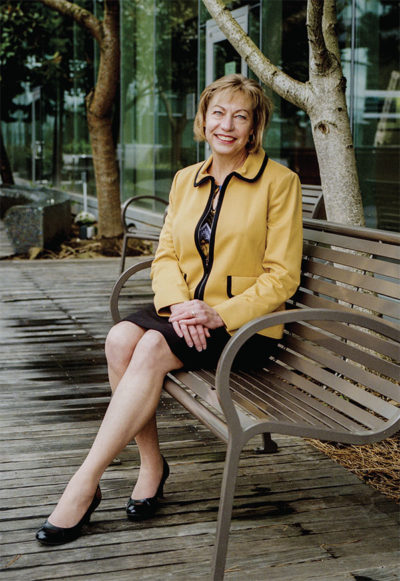
Photo: Isaac Lane Koval
Dr. Renee Edwards, MBA’10, vice president, chief medical officer of Oregon Health & Science University HealthCare
More recently, however, Mourtzinos has seen that distrust fade. A new CEO arrived and encouraged Mourtzinos to go after his interest. After earning his Babson MBA, Mourtzinos joined the hospital’s board of trustees and became vice chairman of its physician compensation plan. In much the same way that many doctors don’t know how to read balance sheets or income statements, Mourtzinos notes there’s a lack of medical knowledge among economists and others who work in health-care policy. “Individuals like myself can bridge this gap,” he says. “We can relate to both sides of the equation by communicating with all parties in a language everyone can understand.”
In that vein, Edwards of OHSU spends about 20 percent of her week in clinic, in part to keep her surgical skills sharp. But she also feels obligated to understand medicine from the inside. “How can I be involved in the work of designing a system, looking for performance improvement opportunities, asking providers to do certain things, unless I am also embedded in that work?” she asks.
Alternative Models for Primary Care
One trend in health care involves shifting from a fee-for-service model, which pays doctors per patient visit, to a value-based care model, which pays doctors based on patients’ outcomes. Insurers reward doctors for reducing avoidable hospital admissions for patients with chronic conditions, such as diabetes or cardiovascular disease. This requires doctors and their teams to be more proactive and focus on care coordination and preventive measures, explains Langer. Providers might check in with patients regularly with the goal of intervening if needed before patients become too sick.
That kind of preventive care appeals to Dr. Scott Early, a current Evening MBA student. A primary care physician in Lawrence, Massachusetts, Early worked for many years at community health centers, helping set up programs intended to improve the health of their mostly low-income patients. At the Greater Lawrence Family Health Center, for example, he established the nation’s first residency program sponsored directly by a community health center. It trained young doctors in community health practice and gave the center the resources to expand patient services such as prenatal care. Early says the city experienced a drop in infant mortality in the 1990s, from 17 deaths per 1,000 live births to eight per 1,000, in part because it was easier for pregnant women to see a provider.
He moved to what is now known as Steward Health Care, where he was vice president of family medicine, and then assumed the chief medical officer role at Lynn Community Health Center (LCHC). In both places, he thought about ways to transform the primary care model but found change to be difficult. “I remember endless faculty conversations about how to teach our residents to take care of really sick and complicated patients in 15- or 20-minute visits,” Early says. “Ultimately, I concluded that it wasn’t possible. Good care takes time. Trying to do the impossible was just burning out the amazing faculty and residents we had attracted.”
In 2015, he left LCHC, began his MBA at Babson, and opened his own practice, Kronos Health, in Lawrence. The central idea at Kronos is that spending more on primary care—hiring more practitioners and giving them more time with their patients—ultimately saves money. The U.S. spends an estimated 5 to 6 percent of health-care dollars on primary care. But Early believes that if insurers doubled that amount to 12 percent, patients could receive more attentive care and need fewer costly interventions. He believes this approach also could prune waste. Early quotes an analysis by the Rand Corp., which found that 18 to 37 percent of every dollar spent on health care goes to unnecessary tests and treatments. But when doctors know their patients well and see them often, Early says, these missteps can be more easily avoided, and patients are less likely to need costly emergency department visits or hospital stays.
Today, most full-time primary care doctors have 1,500 to 3,000 patients and see three to four patients an hour, Early says, a dizzying pace that allows little time to discuss complex health problems. After modeling his theory, Early believes his practice would work best with just 700 patients for each physician, allowing 30 to 60 minutes for each visit. But so far, he hasn’t been able to fully implement this vision. Current models, even those that reward doctors for healthy patients, don’t yet pay enough to fund this type of practice. “So far my wife and I have completely bootstrapped this,” Early says. “We are now breaking even, but without me taking a salary.”
Early has visited insurance companies to discuss new payment models, asking that they invest upfront in the potential savings realized from better care. The companies are intrigued but say his practice is too small, asking that he return when the practice is much larger. “It’s a chicken-and-egg dilemma,” he says, “which is why I’ve concluded that we need venture capital backing to grow.” He says that with a “modest” amount of venture capital he could hire additional staff and purchase practices from retiring physicians. “We could get big enough to attract the interest of some of the insurers,” he says, adding that he has been closely watching Iora Health, a Boston-based health-care company with a similar model that launched with venture capital.
Patients and insurers wouldn’t be the only ones to benefit, Early says; doctors would, too. As it stands now, typical primary care medicine is nicknamed “the hamster wheel.” “Providers are running faster and faster and not getting anywhere,” Early says. “Burnout in primary care is rampant.” As a result, a shrinking number of medical students choose primary care. But Early hopes organizations offering saner schedules and the satisfaction of providing stellar care will attract more young doctors back to the field.
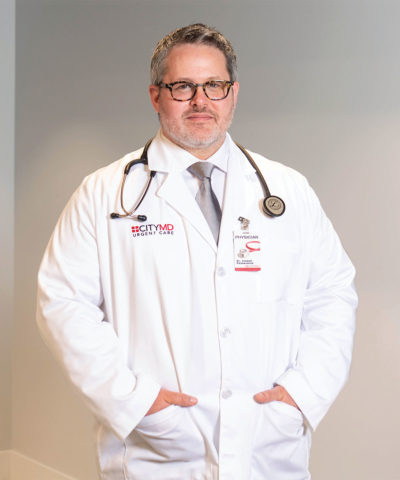
Photo: Chona Kasinger
Dr. Joe Passanante ’91, senior vice president of medical operations, Northwest region, CityMD
Doctor-Patient Connections
Dr. Joe Passanante ’91 saw similar frustration and burnout among emergency-room physicians after working for more than a decade in emergency medicine in the U.S. and China. “I love the adrenaline rush of the ER and being ready for any type of emergency, but there is a point when the night shifts take a toll, and dealing with the human condition in extreme situations takes a toll,” he says.
After seven years in China, Passanante was attending a medical conference in the U.S. when he met a group of ER physicians who seemed unusually enthusiastic about their work. He learned that they had launched an urgent-care company, CityMD, that aimed to provide excellent customer service while fostering a company culture of kindness. After shadowing a CityMD doctor in New York City, Passanante was impressed and joined the staff in December 2013. Since then Passanante has become partner and senior vice president of medical operations, Northwest region; he is based in Seattle, where he has opened five sites in the past two years.
CityMD has 100 sites in the U.S. and competes both with ERs and other urgent-care companies. Feedback from its patients often highlights the speed and quality of care, Passanante says. The average wait time at its facilities is eight minutes for walk-in visits, well below that of most ERs. “Emergency departments have specific triage protocols that place the least urgent cases at the back of the line,” Passanante says. “It’s commonplace for a patient to wait two-plus hours to have their urinary tract infection treated.”
He believes CityMD’s operating model helps keep patients and staff happy. For example, the company hires medical scribes to accompany doctors as they see patients. The scribes take notes and enter all information into the computer system, saving doctors time and allowing them to connect more easily with patients during visits, Passanante explains. A dedicated aftercare team works to get test results to patients and to schedule follow-up care. An emphasis at CityMD on hiring employees who value kindness contributes to a pleasant atmosphere. “When kindness is a shared goal,” says Passanante, “it’s easy for the team to row in the same direction.”
In Oregon, Edwards also is thinking entrepreneurially about ways to improve patient care while holding the line on costs. Next spring, OHSU plans to open a new building devoted largely to surgical care. Increasingly, surgeries have become minimally invasive, notes Edwards, which means less patient recovery time and trimmed coverage from insurance companies. So the new building was designed to move these patients quickly and safely through their procedures and into recovery with fewer staff members. “I created a multidisciplinary team charged with ‘modeling’ this new care concept using an existing floor of our current hospital,” Edwards says, giving the surgery team a place to experiment with different patient-flow and nursing-care routines and time to perfect them before the move.
Much of Edwards’ work as a health-care administrator has been about dismantling the silos common in medicine. This was particularly difficult early in her career at OHSU as she helped expand the Center for Women’s Health, where specialists from many departments worked together. “We struggled a lot because finances follow departments,” she says, and departments were not always willing to share revenue across the multidisciplinary center. “We created new financial and practice models that allowed multiple specialties to work together more efficiently,” Edwards says, though she acknowledges that departments still wrestle with these questions.
“Doctors are not generally encouraged to stray from ‘the way something should be done,’” Edwards says. “We are taught to follow standard protocols. An entrepreneurial education challenges a physician to think differently, to break out of the mindset of following set rules and consider alternate paths.”
Edwards remembers a big shift in her own thinking during her MBA coursework, when she began to consider a new marketing and communications strategy for the Center for Women’s Health that emphasized social media. “We hired a communications person and worked to develop as many direct-to-consumer venues as we could,” Edwards says. She even opened her own Twitter account to address hot medical topics. In the staid world of academic medical centers, she says, these steps stood out.
The Entrepreneurial Difference
Other Babson-educated physicians say they view problems and solutions differently as well. Passanante didn’t take a standard path into medicine or to his current role with CityMD. He admits that after graduating from Babson he was somewhat “rudderless,” drifting without passion between jobs for a few years until he read a 1993 Chicago Tribune profile of a pediatric plastic surgeon. “I thought ‘Wow! That sounds significant.’ I just couldn’t think of a better career than helping babies with birth defects,” he says.
Passanante made an appointment with the dean of the medical school at Northwestern University in Chicago to ask about requirements for admission. “He did his best to talk me out of it,” Passanante says. “But I was absolutely not going to take no for an answer.” So the dean recommended that he take some college-level science courses and find ways to learn more about medicine. Passanante took the classes and became an EMT and a paramedic. He then worked as a lab tech for a DNA researcher and in the Cook County morgue, assisting with autopsies. Meanwhile, he continued to check in with the dean at Northwestern, who eventually gave him the green light to apply. Passanante was accepted and began medical school in the fall of 1998, later opting for a residency in emergency medicine.
He believes the entrepreneurial focus of his Babson education shaped the way he has approached his career as a doctor. “Entrepreneurship is seeing problems and just tackling them, not looking to other people to tackle them for you,” he says. For example, during his residency, Passanante wanted to take an elective in wilderness medicine, but such electives were rare at the time and Northwestern didn’t offer one. “I did what any Babson student would do, and I started one,” Passanante says. He recruited 10 students and used their fees to hire instructors from a top wilderness leadership company. The students received credit for the four-week course, and the following year, says Passanante, the program was adopted by Harvard Medical School, which has run it annually ever since.
Passanante also completed electives that involved working in ERs in other countries, including Turkey, Romania, and Italy. After residency, he accepted a job working in an ER at Beijing United Family Hospital during a time when few U.S.-certified ER doctors were in China. He also was tapped by the Secret Service to serve as a trauma expert in presidential motorcades when Presidents Bush and Obama visited Beijing. In each situation, he loved the challenge of working in unfamiliar territory “without guardrails,” an instinct he says he developed at Babson.
Langer used entrepreneurial thinking to address a gap she saw in the system. Last fall, she entered a Shark Tank-style business competition sponsored by Northeast Arc, an agency that supports adults and children with disabilities, and was one of three winners. In front of a crowd at Boston’s JFK Library, Langer pitched her idea for a program called Pathways to Inclusive Healthcare (PIHC). Modeled on Teach for America, the program now is housed at the Eunice Kennedy Shriver Center at the University of Massachusetts Medical School and invites recent graduates planning to enter health professions to spend a gap year after college working at one of four practicum sites offering services for people with disabilities. “The idea is to generate a pipeline of future health-care professionals who really understand and are enthusiastic about working with this population,” Langer says.
Her idea came from personal experience as the parent of a 21-year-old son, Jonathan, who has autism and intellectual disabilities. Langer was dismayed to learn that as Jonathan transitions out of pediatric care, adult primary-care practices often are ill-equipped to handle his needs. “The staff doesn’t necessarily have the training in how to manage these patients and understand their challenges, often resulting in wide health disparities in disabled populations,” Langer says. Even the floor plan at most adult primary-care practices—offices with large, often-crowded reception areas—can be overwhelming to people with autism, Langer says.
Her goal is to train PIHC scholars before they enter graduate programs about how to meet the needs of people with disabilities. Recently, Langer accepted a new position as chief medical officer of Fallon Health, but she will continue to volunteer her time to launch PIHC. The program currently is soliciting applications from college seniors and plans to welcome its first group of scholars in September.
Paths to New Solutions
The combination of medical and business knowledge also could yield solutions for health-care problems outside the United States. A native of India, Dr. Sthuthi Jebaraj, MBA’18, spent two years working in a small hospital in a poor, rural part of Maharashtra, India’s second-most populous state. She was following in the footsteps of her parents, an orthopedic surgeon and psychiatrist who also worked in Maharashtra for years and instilled in their three children a desire to help others. “I saw that there were many issues with the health-care system in the state, and I wanted to study public health,” Jebaraj says. She received a Fulbright scholarship to earn her master’s degree at the Harvard School of Public Health and then returned to India to work for a nonprofit, World Vision India, where she ran health and nutrition programs for women in poor, rural areas.
In 2013, Jebaraj married an epidemiologist, and following her husband’s job, they settled in the Boston area. She spent time volunteering for a range of nonprofits, learning about poverty and hunger in the U.S., before entering Babson to earn her MBA. Physician friends teased her about going over to the “dark side” of business and profit, but Jebaraj’s coursework led her to see the potential for profit to do good in the world. Understanding finance can help clinics run more efficiently, she notes, and analyzing markets can help target needed care. In Maharashtra, Jebaraj says, her hospital often would run out of government-supplied medicines. So she was intrigued to learn in a supply-chain course about novel methods used in Africa to track medications through the manufacturing and distribution process.
She also has been pondering ways to use web-based technologies to help medical staff in remote regions remain current without the burden of travel. And she sees the need for tools to help entrepreneurs in developing countries share and disseminate information and innovations.
Jebaraj says she and fellow Babson-trained physicians see the challenges of health care as opportunities. “We think of why patients get sick in the first place, how they will afford treatment, whether their home situation will allow them to get better,” she says. “A business education gives us the language and tools to understand the big picture and consider the many avenues to make patients’ lives better.”
Erin O’Donnell is a writer in Milwaukee.
]]>But just a few days later, national events prompted him to put aside that plan. On July 6, a black man named Philando Castile was fatally shot by a police officer during a routine traffic stop in Falcon Heights, Minnesota. Then on Friday, July 8, Ryan woke to learn that a sniper had killed five police officers in Dallas the night before during a protest against police brutality. “I realized that there was something bigger than my plan,” he says.
Ryan consulted with his core leadership team and sent what he considered to be “a fairly unspecial email” to the company, acknowledging the events. “It said, ‘It troubles me, I’m sure it troubles you, and we don’t have the answers. But I want to let you know I care, it’s on my mind, and we should feel free to talk to one another about it,’” Ryan recalls.
Hundreds of PwC employees responded to Ryan, but one email stood out: A woman thanked him for encouraging people to talk, because when she arrived at work that Friday, she said, “The silence was deafening.” The words were a wake-up call. “Here we were, one of the most progressive organizations in the world,” Ryan says, “yet when the country was feeling down because something bad had happened, our people couldn’t talk about it.”
He decided PwC’s 50,000 employees needed a chance to talk. He chose a day and encouraged everyone to step away from client work for an event called ColorBrave. Employees could converse in groups ranging in size from two to 200 people, but they had to follow a few simple rules: Be respectful, talk about how you feel, and focus not on “right” or “wrong” but on understanding each other.
In Ryan’s group, he heard one black employee describe what it’s like to earn a significant salary yet have people question whether his car really belongs to him. A white employee described the social challenges of her interracial marriage to a police officer. Participants found the experience moving. Someone commented to Ryan: “We shed more tears on July 21, 2016, than we did in our entire 160-year history.”
Babson strives to be an inclusive, intentionally diverse community, from students to faculty, staff, alumni, and external partners. But diversity is a complex issue, says Sadie Burton-Goss, chief diversity and inclusion officer at Babson. “Diversity is about race, gender, ethnicity, nationality, socioeconomics,” she says. Building, supporting, and retaining a diverse community takes commitment, collaboration, and work.
Read More…
Corporate efforts to address diversity and inclusion—usually by hiring employees of various backgrounds, from gender and race to ethnicity and sexual orientation and more—are not new, of course. Ryan notes that decisions by the two PwC chairmen before him laid the groundwork for his leadership team, which includes women, minorities, and an employee who identifies as LGBTQ. The company reports that women make up 47 percent of its workforce and minorities 33 percent. But Ryan stresses that more work needs to be done and that real progress in diversity and inclusion involves more than percentages.
Ryan’s actions, along with the work of other Babson alumni, suggest the dawn of a new era in the effort to diversify corporate America. “We should be the generation of leaders that makes inclusion a reality for America once and for all,” Ryan says.
Diversity Is Good for Business
As a gay black man, Aaron Walton ’83 has always known what it means to stand apart. Growing up in the Boston neighborhood of Roxbury, he was one of the first kids to participate in a program that bused mostly minority children from inner-city neighborhoods to schools in affluent, mostly white suburbs. His parents then moved the family to Bellingham, Massachusetts, where someone circulated an unsuccessful petition to push the African-American family out of the neighborhood. Later, Walton’s parents sent him and his younger sister, Valerie ’85, to a private school for grades 7 to 12 and then to Babson. “At every school, my sister and I were usually the only black kids there,” he says. He often felt the weight of people’s misconceptions and stereotypes, fielding such questions as why he didn’t “sound” black. Back then, he coped by shrugging off those comments.
When Walton joined PepsiCo after graduation, he began to see his differences as beneficial and a source of fresh ideas. His supervisors agreed. Walton started as an analyst and then moved to brand management and the entertainment marketing team, where he was valued as an expert on pop culture and the entertainment business. “Being black and gay exposed me to a wider range of art forms than some of my colleagues,” he says. Walton focused on ways that PepsiCo could use art, music, and film to tell the brand’s story, developing sponsorship deals with acts such as Gloria Estefan, Tina Turner, and Michael Jackson, among others.
Walton eventually left PepsiCo to spend 13 years at his own entertainment marketing agency. But he wanted to fulfill a longtime dream of working in advertising, so in 2005 he co-founded his own agency, Walton Isaacson, with colleague Cory Isaacson and backing from former basketball star Magic Johnson. Walton and Isaacson set out to create what they called “the world’s most interesting agency,” one that celebrates all kinds of diversity. “We understood that diversity ultimately leads to innovation,” Walton says. “When we’re surrounded by people who aren’t like us, we work harder to marshal our arguments to convince people why things need to evolve or be different. That can’t happen if everyone thinks the same, looks the same, comes from the same background.”
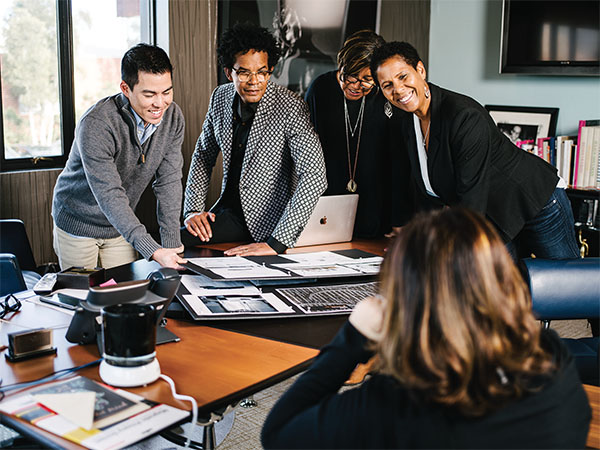
Photo: Mathew Scott
Aaron Walton ’83 encourages collaboration among all employees at his agency, Walton Isaacson.
Today the agency employs a remarkably diverse team, with more women than men and staff members who identify as black, Asian, Latino, mixed race, and LGBTQ. Walton is careful not to “silo” or limit his team by, for example, having Latino staff members work only on Latino accounts—an approach that is common, he says, at traditional ad agencies. Clients and employees benefit from exposure to a range of perspectives, he believes. Early in his career, Walton tended to ignore narrow-minded comments from clients, but not anymore. “I finally began to work with clients to explain the negative impact that stereotypical assumptions were having on their business,” he says. “It’s not a difficult concept. Let’s own and celebrate our diversity and all of the amazing things that come along with expanding our view of the world instead of marginalizing these cultures.”
Walton celebrates his own identity and also encourages employees to be fully themselves. “Being able to celebrate all of who we are is freeing,” he says. “People are less focused on conforming and more focused on innovation and being able to provide a point of view that no one else has.”
Diversity efforts at Babson go right to the top. Amanda Strong ’87, a Babson trustee, has worked with President Kerry Healey and others in the Babson community to make the Board of Trustees more representative of people of all backgrounds.
Read More…
Josuel Plasencia ’17 and Yulkendy Valdez ’17 say this level of acceptance is particularly appealing to millennial workers. The recent grads founded Boston-based Project 99, which helps companies teach young employees and their managers inclusive leadership skills, with the aim of retaining diverse talent and growing future leaders. “Professionals of color are three times more likely to quit their jobs, and this is costing companies an average of $6 billion a year,” Valdez claims. “Our idea is that if you’re able to put these millennials—who are going to become three-fourths of your workforce in less than 10 years—at the forefront of cultural change in the company, they are going to be more engaged, they’re going to feel more productive, and they will deliver for your bottom line.”
Studies show that more ethnically and racially diverse companies tend to outperform their less diverse competitors, say Plasencia and Valdez. The same goes for companies with more women leaders; they often have better financial performance than male-dominated competitors.
Plasencia and Valdez both were born in the Dominican Republic and moved to the U.S. as children. Plasencia was raised by a single mother in New York after his father was deported. Valdez lived near Ferguson, Missouri, and often worried about her little brothers when she saw news of a person of color dying at the hands of police. The two founders chose the name of their company after learning about the human genome at the 2014 Clinton Global Initiative conference; President Bill Clinton mentioned that 99.9 percent of human genes are identical, and differences among people account for only 0.1 percent of our genetic material. “We’re always asking, ‘How can you create leaders that embrace that common humanity that we all have but leverage the unique differences that we all bring to the table?’” Valdez says. “Imagine if Josuel was able to talk openly at work about his family, about living with a single mother and having a deported father. Imagine how much more at ease I would feel at work if I was able to talk about how police brutality in the African-American community impacted me growing up in St. Louis. These are the things we’re trying to do with Project 99, to help companies let out the 0.1 percent in all of our cultures so that people can be more engaged and more productive at work.”
Helping employees feel included and respected can be as simple as offering a listening ear, says Minea Moore, MBA’08, director of diversity and inclusion strategic initiatives at Intel. To that end, the high-tech company created the WarmLine, a program designed to help retain employees and staffed by advisers who troubleshoot a variety of confidential topics, especially around career goals. Since 2016, the line has processed around 10,000 cases, and research shows that 90 percent of those employees stay at Intel. Moore adds that hiring and retaining people with different ethnicities, genders, and sexual orientations creates important diversity of thought and different perspectives within a company. This kind of thinking, Moore says, can benefit the bottom line.
Nicole McCabe ’96 is now vice president of strategic initiatives in corporate development at software company SAP and was its global head of gender equality for almost five years. She says companies ignore diversity and inclusion at their peril and offers the example of Uber, which faced a dip in ridership after a female engineer detailed rampant sexism at the company. “You see a lot of these startups that aren’t thinking about their culture early on,” she says, “and then they grow and they’re successful, but they have all of these issues embedded into their culture that create a huge financial risk.”
Commitment at the Top
In January 2015, Intel CEO Brian Krzanich stood on a stage at the Consumer Electronics Show, which attracts almost 180,000 attendees and garners worldwide media coverage, and made a dramatic pledge: By the end of 2018, Intel would reach “full representation” within its workforce. “That means when you look at the makeup of employees inside Intel, it should match the available talent pool outside Intel,” Moore says. In the same speech, Krzanich committed $300 million to support that goal and accelerate diversity and inclusion, not just at Intel but across the technology industry.
Intel’s approach to diversity and inclusion is grounded in data. “We believe that what we measure gets done,” Moore says. “By setting measurable goals based on data, we’re able to ensure that we’re progressing.” These efforts appear to be working: In a total U.S. workforce of about 50,000, the gap to full representation is about 800 people today, down from 2,300 in 2014.
Ryan of PwC agrees that diversity efforts must start with company leaders. “The tone at the top and executive commitment is the single most important thing,” Ryan says. He adds that talented CEOs are particularly well-equipped to tackle tough problems creatively. “They can get transformative deals done,” he says. “They can be entrepreneurial. They can develop new technology. They can raise money and sell companies. When they put their minds to this, they can get it done.”
As a white man who spent his early childhood in the then mostly white Hyde Park neighborhood of Boston before moving to a predominantly white suburb, Ryan may seem a surprising leader in the quest for diversity and inclusion. But he witnessed the Boston busing crisis in the mid-1970s, when a court ordered the desegregation of Boston city schools. The nightly news showed frightening footage of rioters throwing rocks at buses. Images from this confusing time stuck with him.
After the success of the first ColorBrave conversations at PwC, Ryan admits he breathed a sigh of relief and planned simply to continue with existing efforts to recruit diverse talent. But a member of his team pressed him about his influence with companies outside of PwC. What could Ryan do to promote diversity and inclusion elsewhere? “That really, really got me thinking,” he says. As he traveled the country, meeting as usual with PwC clients, Ryan asked CEOs about diversity. “It became clear that many were struggling with how to become more inclusive and were not quite sure how to do it but wanted to do better,” Ryan says.
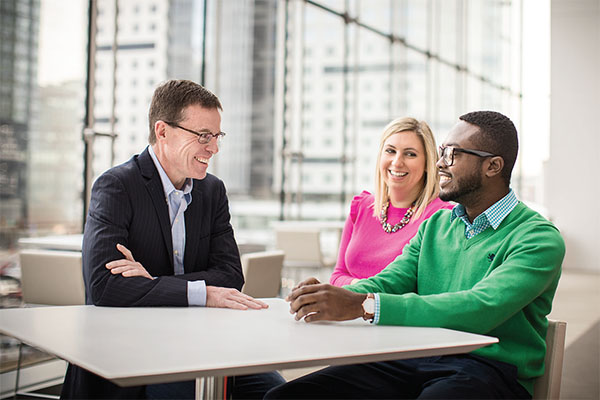
Photo: Tom Kates
Tim Ryan ’88 talks with employees in PwC’s Boston office.
He reached out to the CEO of consumer-goods company Procter & Gamble and the head of the Executive Leadership Council, an organization for the development of black leaders, as well as to PwC’s direct competitors. Conversations with these leaders eventually led PwC to launch an initiative called CEO Action for Diversity & Inclusion. Participating executives agree to take three steps: to create safe spaces in their companies for conversations about diversity, to provide training about unconscious bias to everyone, and to make best practices for diversity available to other businesses.
More than 360 companies now participate. This past November, 70 CEOs from these companies gathered in New York for a closed-door session about diversity, where leaders were encouraged to talk about uncomfortable topics. “We had an incredible day, where we all left smarter and maybe a little more courageous than we were coming in the door,” Ryan says. As part of its CEO Action initiative, PwC also recently added what it calls the President’s Circle, bringing academic institutions and associations on board. The goal is to engage students, faculty, and staff around issues of diversity and inclusion, given that students are the future employees and leaders of corporate America.
How to Recruit a Diverse Workforce
Finding qualified employees from diverse backgrounds is not as difficult as some people claim, believes Ryan. “I would say that’s one of my biggest pet peeves. We need to do a better job of finding the talent inside our organizations, broadening our recruiting nets and the like,” he says. “There’s so much talent out there in the world. To simply say it’s a talent pipeline issue, in my judgment, is a cop-out.” A CEO Action event addressed this issue, inviting 150 chief diversity officers and human capital officers to New York to share detailed strategies for inclusivity.
Several years ago, McCabe tackled the dearth of women in leadership roles at SAP by scheduling a two-day meeting on the topic. “I brought together everyone who handled core employee life-cycle processes—executive recruiting, our university recruiting folks, our succession planning folks, the people who handle leadership,” she says. “We talked openly about the data and the issues.”
They found, for example, that just 10 percent of employees in SAP’s fast-track leadership program were women. “The intent of the program was to accelerate future leaders, but how can you increase diversity when the primary recruiting pool is not diverse?” McCabe notes. So the group discussed ways to boost women applicants. “It was a great opportunity for everyone to get on the same page and understand the impact of their area on the greater goal,” she says. “Once you put the data up there, no one can really argue with it.” The proportion of women in leadership roles at SAP rose from 19 percent in 2011 to 25 percent in 2017, meeting goals the firm had set six months ahead of schedule.
In April 1998, a Black Affinity meeting at Babson led to the first Black Affinity Conference, now observing its 20th anniversary. Created to engage and retain students, improve recruitment, and re-engage alumni from the black community, the BAC continues to bring people together for learning, networking, and celebrating.
Read More…
Intel hopes that boosting STEM programs in schools will ultimately yield a larger, more diverse pool of technically trained employees in the future. In 2015, the company announced a $5 million investment in the Oakland Unified School District in California, including close partnerships with the district’s largest high school, Oakland Technical, and McClymonds High School, where students of diverse backgrounds make up about 90 percent of the population. The grant funded a new position to oversee the district’s computer science programs and a new computer science curriculum, as well as mentoring and summer internships at Intel. “When you look at how to fill the lack of diversity in technology, you need to start earlier than college,” Moore says. The changes already have helped, she says, pointing to a dramatic increase in the number of Oakland students taking computer science classes in the past two years.
While the company is making steady progress in its efforts to hire women and Hispanic and Native American employees, Intel is still lagging in its goals around the hiring, progression, and retention of African-American employees, Moore says. So Intel is increasing its focus on retention efforts and expanding recruitment at historically black colleges and universities. It also plans to host an African-Americans in Tech Thought-Leadership Summit to consider new ways to attract and keep black employees in these roles.
Plasencia of Project 99 says that one secret to retention is giving young minority employees opportunities to lead projects and teams. “This increases their ability to have a voice and makes them a stronger part of your organization,” he says. “They are more likely to stay and want to grow in the company.”
Companies also need to look at the role that unconscious bias—the judgments and assessments that people make without realizing they are doing as much—may play in hiring, Walton says. “I think every organization has it,” he says. “It helps to start to understand how it impacts your hiring decisions or impacts the clients you go after.” Making diversity “part of the DNA” of a company from the beginning, as Walton and his co-founder did, can help safeguard against such biases. Emphasizing a true willingness to listen intently to other people also is key, Walton adds. “Too often, people enter a conversation with a mental checklist of what they want out of it,” he says, “and their brains check out as soon as they establish that the other person meets their expectations—or doesn’t.”
A growing number of companies offer unconscious-bias training to help workers understand blind spots around diversity. PwC developed its training with Mahzarin Banaji, a Harvard professor and co-author of Blindspot: Hidden Biases of Good People. Ryan describes one scenario offered in PwC’s training: A car crash occurs, killing a father and gravely injuring his son. When the son arrives at the hospital, the surgeon says, “I can’t operate. This is my son.” Many people respond by wondering how that’s possible, given that the father died. But the surgeon is actually the patient’s mother. PwC requires the training for all new employees, as well as for established employees who want to be considered for a promotion. PwC’s President’s Circle also is calling on university leaders to help build diversity and inclusion course offerings into their curricula, and it has created a campus tour called Check Your Blind Spots, which pushes students to consider such issues before they enter the workforce.
Intel’s Moore acknowledges that corporate diversity training touches on sensitive topics. The company offers Managing at Intel, a program that includes diversity and inclusion training for its managers. “This stuff is hard,” she says. “You hear things that may hurt, and those unconscious biases are not an easy pill to swallow. But a healthy dialogue, actually having a discussion about it, is necessary to really drive change.”
Moving Away from Mandates
In her second job out of college, Moore, who is African-American, had a conversation with an older white male colleague. He expressed opposition to what he called “affirmative action” programs, which he believed hurt the employees they were designed to help. After working together for about a year, the colleague gushed to Moore that he was really impressed with her work. “I connected the dots back and realized that he probably thought I originally got that job not because of my capabilities, but because of ‘affirmative action,’” she recalls. “It was the first time that I realized people might be looking at me differently.”
During her career, Moore has seen thinking about diversity and inclusion initiatives change. Instead of viewing such programs as a way to comply with mandates and legal requirements, companies now are more likely to see them in terms of the tangible value they bring to businesses, she says.
Diversity and inclusion experts are working to move employees away from viewing diversity initiatives as an imposition. McCabe of SAP has come to realize that empathy is a key ingredient in making these programs productive. She helped boost SAP’s existing Business Women’s Network, and with a colleague she co-founded the Leadership Excellence Acceleration Program, which prepares women for leadership roles. McCabe notes that in 2016, SAP became the first tech company to earn Economic Dividends for Gender Equality (EDGE) certification, a global business standard for evaluating gender equality.
Sensing a lack of connection among female colleagues, McCabe also established a less-formal collaboration website to build community among SAP women. It features a webinar series, attended by women across the company. She chuckles thinking about the distancing politeness of the first webinars. Within a few sessions, however, attendees grew more candid and started sharing personal stories. One woman talked about a recent cancer diagnosis, for example, and women from all over the world chimed in to offer support. “You could see the trust and support that they started to bring to one another,” McCabe says.
Experiences like those reshaped her thoughts about what makes diversity initiatives effective. “Now it’s more, how do we evoke empathy for people? How can we help our employees have conversations, and, in some instances, relearn the process of agreeing to disagree?” McCabe says.
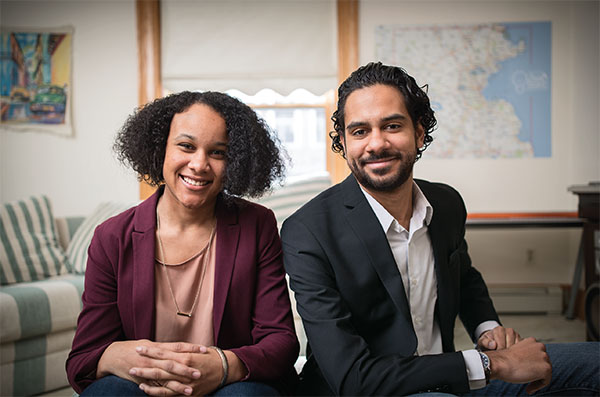
Photo: Tom Kates
Yulkendy Valdez ’17 (left) and Josuel Plasencia ’17, co-founders of Project 99
Valdez and Plasencia agree that stilted, forced conversations about race and diversity need to be replaced. “You’ve got to turn a transactional conversation into a human conversation again, which is going to be hard because these topics have been so politicized, especially recently, and have become very tense,” Valdez says. “You’ve got to find a way to sit in a room, starting with small pockets of your organization, and just talk about your own personal story. Start there, and then talk about how this has personally impacted you.”
Diversity and inclusion are worthy causes, Ryan reiterates. “It happens to be the right thing to do,” he says. At the same time, corporations will benefit from these initiatives. “When we make our companies more diverse,” Ryan says, “we create our country’s biggest competitive advantage.”
Erin O’Donnell is a writer in Milwaukee.
]]>